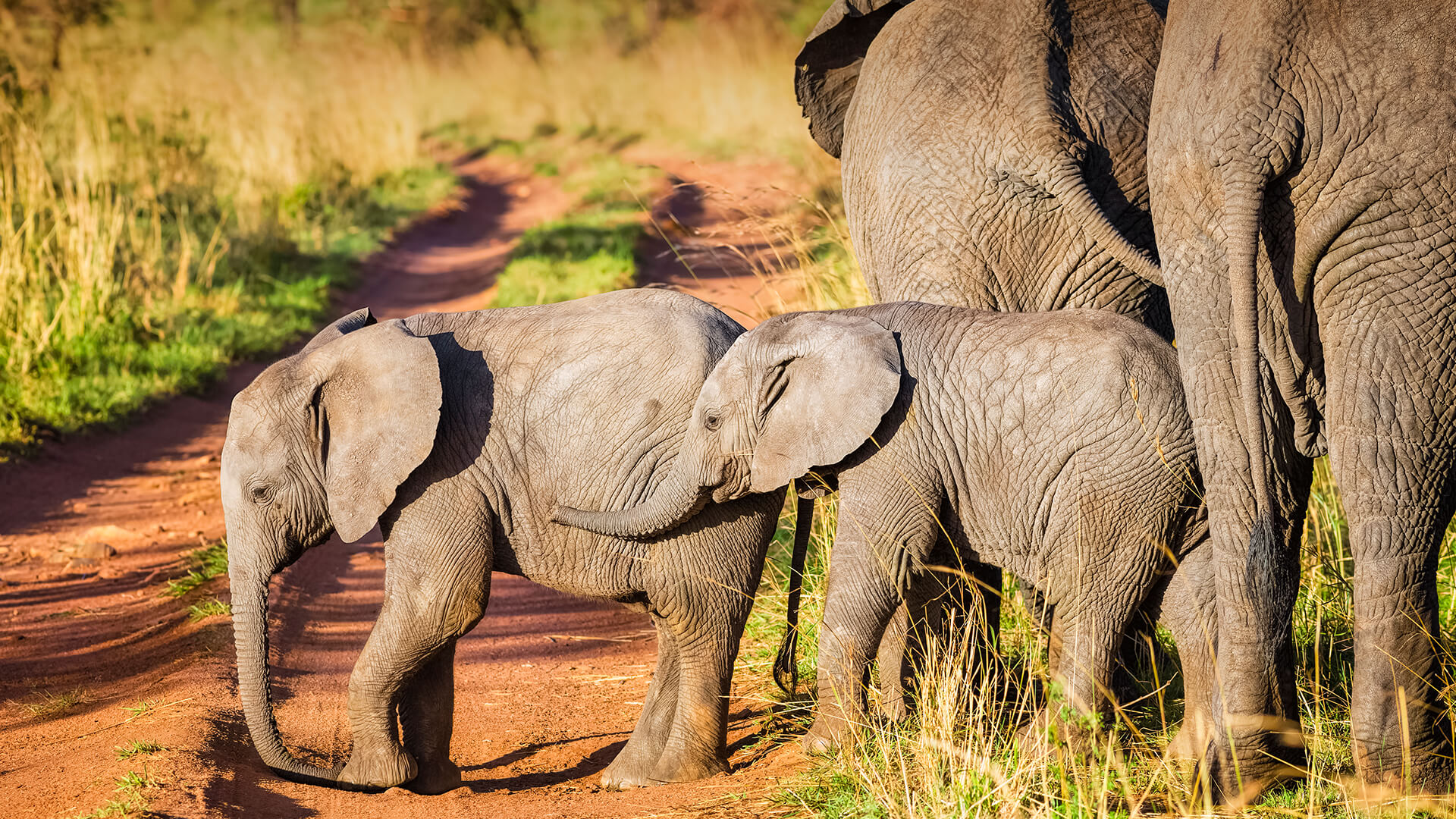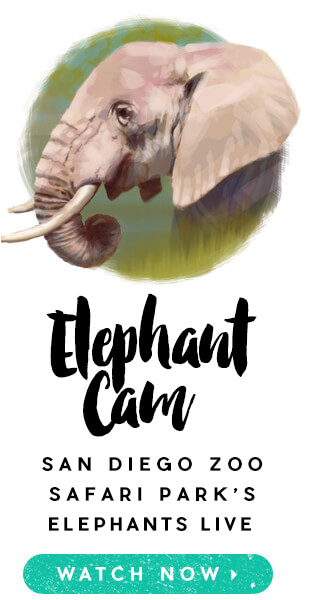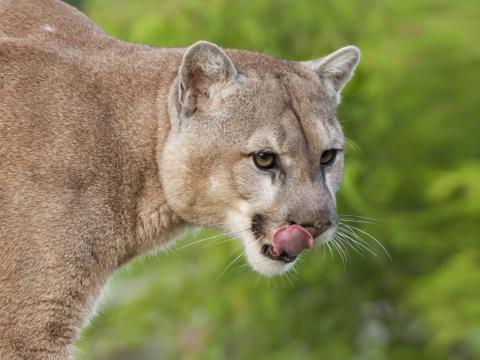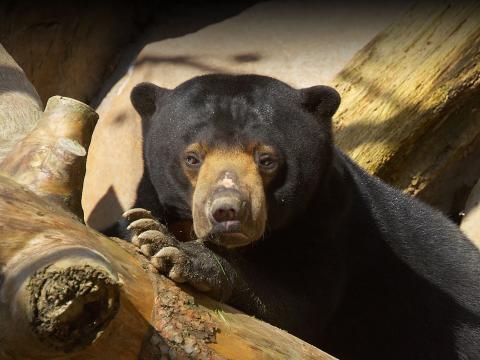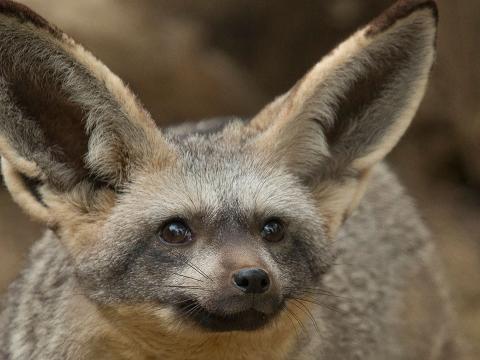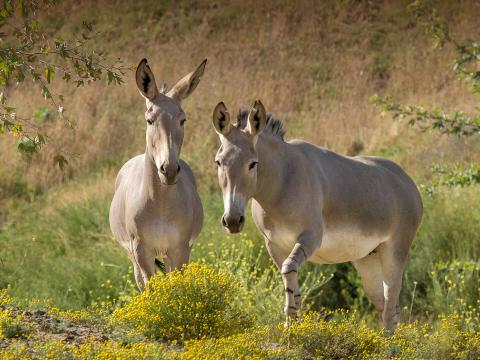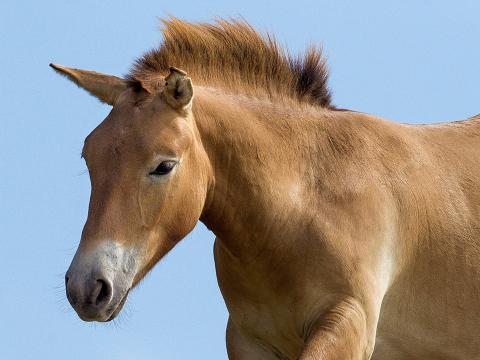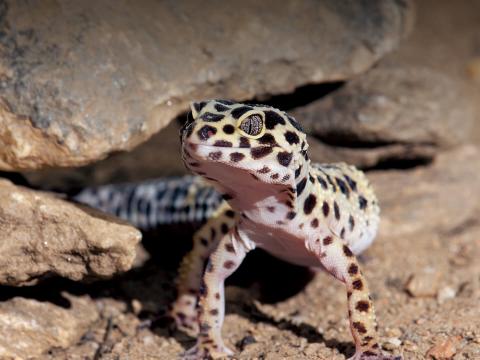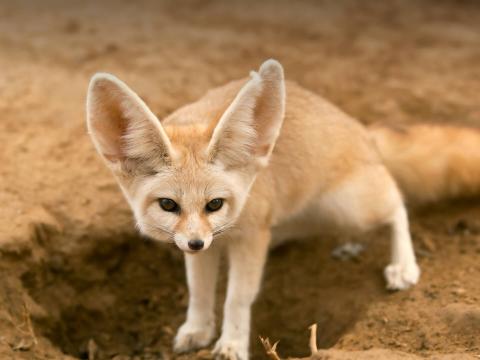Elephant
- Class: Mammalia (Mammals)
- Order: Proboscidea
- Family: Elephantidae
- Genera: Loxodonta (African) and Elephas (Asian)
- Species: africana, cyclotis, and maximus
- Subspecies: E. maximus indicus (Indian), E. maximus maximus (Ceylon), E. maximus sumatranus (Sumatran)
ABOUT
Have you “herd”? They’re enormous and intelligent, strong and sociable. Humans have been impressed by elephants for centuries, simply because they are so big—a male African elephant can weigh up to 7.5 tons (6.8 metric tons)! They also amaze us with their long and flexible noses, large and flapping ears, and loose, wrinkly skin. There are many stories about elephants—you’ve probably heard of Horton, Babar, and Dumbo.
If all elephants seem the same to you, take a closer look. There are three types of elephants that are usually recognized: the African savanna elephant, the African forest elephant, and the Asian elephant. There is some ongoing debate about how many subspecies may exist, or whether some of these might, in fact, be species in their own right. Here are a few ways to tell them apart:
- African elephants (both species) have large ears that are shaped like the continent of Africa, both males and females have visible tusks, their skin is very wrinkly, their back is swayed, and the end of their trunk works as if they have two fingers there to help them pick things up. African elephants are the largest mammals on land.
- Asian elephants have smaller ears, usually only the males have visible tusks, they only have one “finger” at the end of their trunk, and their back is dome-shaped.
Cool ears! An elephant’s ears are a like an air conditioner. As elephants flap their ears on a hot day, the blood flowing through the many blood vessels in the ears is cooled. If they have just splashed around in a river, all the better! This ear flapping behavior cools their large bodies on warm days.
The skinny on skin. The term “pachyderm” is from the Greek word pachydermos, which means “thick skinned,” and this term often refers to elephants, rhinos, and hippopotamuses.
An elephant’s skin can be up to 1 inch (2.54 centimeters) thick on some parts of its body. It’s also loose, which makes the elephant look like it’s wearing baggy pants or sagging stockings. But there’s a good reason for this—it keeps the elephant cool by trapping moisture that takes longer to evaporate. And even though it’s thick, an elephant’s skin is also very sensitive to touch and sunburn. Elephants often spray themselves with water or roll in the mud or dust for protection from the sun and biting insects.
Really long in the tooth. Tusks are an elephant’s incisor teeth and are the only incisors an elephant has. They are used for defense, digging for water and food, and lifting things. The tusks present at birth are milk teeth, which fall out after a year when they are about 2 inches (5 centimeters) long. Permanent tusks extend beyond the lips at about two to three years and grow throughout an elephant’s life.
The tusks are composed of ivory (dentine) beneath the outer layer of enamel, but the peculiar diamond pattern of the elephant’s tusk gives it a distinctive luster that ivory tusks of other mammals such as hippos, warthogs, walruses, and sperm whales don’t have, and African elephants are sometimes killed by poachers just for their ivory tusks.
Elephants also have four molars, one on the top and one on the bottom on both sides of the mouth. One molar can weigh about 5 pounds (2.3 kilograms) and is the size of a brick! Each elephant can go through up to six sets of molars in its lifetime.
New teeth do not erupt vertically, as in most mammals, but grow in from behind, pushing the old worn-out teeth forward and out, like a production line of teeth moving along the jaw from back to front. In very old elephants, the last (sixth) set of molars can become sensitive and worn down, and the elephants they prefer to eat softer food. Marshes are the perfect place for soft plant food, so old elephants are often found there. Many times they stay there until they die. This practice led some people to think that elephants went to special burial grounds to die.
The nose knows. An elephant’s trunk is both an upper lip and a nose. There are 8 major muscles on each side of the trunk and 150,000 muscle fascicles (portions of muscles) for the entire trunk. There are no bones or cartilage in this unique appendage. An elephant’s trunk is so strong it can push down trees and so agile that it can pick up a single piece of straw. Elephants also use their trunk like we use our hands: to grab, hold, pick up, reach, touch, pull, push, and throw.
The trunk is still a nose, too, and has two nostrils at the end that suck air up the long nasal passages and into the lungs. Elephants also use their trunks to drink, but the water doesn’t go all the way up the nose like a straw; instead, the elephant sucks water only part way up the trunk, curls it toward its mouth, tilts its head up, and lets the water from the trunk pour in.
Sounds of music. Elephants make many different sounds; humans cannot hear some of these sounds, as their frequency is too low for our ears. Elephants use these sounds to communicate with each other over long distances. Have you ever had your stomach growl at an unfortunate moment? Well, stomach growls are a welcome sound in elephant society; a stomach that makes loud rumbling and growling noises seems to signal to others that everything is “okay.”
The largest elephant on record was an adult male African savanna elephant. He weighed about 24,000 pounds (10,886 kilograms) and was 13 feet (3.96 meters) tall at the shoulder! Most elephants don’t get that large, but African elephants do grow larger than Asian elephants.
HABITAT AND DIET
Home is where the herd is. Asian elephants live in India, Nepal, and parts of Southeast Asia. Their habitat is scrub forest and rainforest, and they are often found along rivers during dry months.
African savanna elephants (Loxodonta africana) are found in eastern, central and southern Africa, living in lowland and montane forests, flood plains, and all types of woodland and savanna. The smaller African forest elephants (Loxodonta cyclotis) inhabit the Congo basin and western Africa in moist, semi-deciduous rainforests.
Elephants eat all types of vegetation, from grass and fruit to leaves and bark—about 165 to 330 pounds (75 to 150 kilograms) each day, which is about 4 to 6 percent of their body weight. They spend an average of 16 hours per day eating! African elephants are grazer-browsers and eat grasses, including sedges, flowering plants, leaves, shrubs, and small- to medium-size trees. African forest elephants are browser-frugivores and eat leaves, fruits, seeds, branches, and bark. Asian elephants are both browsers (feeding on shrubs and trees during the dry season and after heavy rains) and grazers (feeding on grass during the first part of the wet season). They can consume many types of plants, including twigs and bark. The choice of plants varies with seasons.
The elephants at the San Diego Zoo and the San Diego Zoo Safari Park eat a bit less than their counterparts on the savanna—about 125 pounds (57 kilograms) of food each day—because they don’t have to burn as many calories looking for food. Still, the adult male African elephants at the Safari Park need to eat over 70,000 calories each day! Our elephants are offered hay, herbivore pellets, acacia browse, celery, cucumbers, and lettuce daily. Elephants drink 20 to 50 gallons (75 to 190 liters) of water each day.
FAMILY LIFE
Most elephants live in close social groups called herds, usually made up of related females and their offspring. The leader of the herd is known as the matriarch; she is usually the oldest and most experienced female in the group. The matriarch remembers where and how to find food and water, how to avoid predators, and the best places for shelter. She also keeps the younger elephants in line and teaches them how to behave in elephant society. In some cases the group may include one of the matriarch’s sisters and her offspring. When groups get too big, “bond groups” split off but maintain a loose association.
Adult males don't usually live in a herd. Once male elephants are old enough to find their own food and protect themselves, they leave the herd and live on their own or form bachelor herds with other males. Only after they become adults do they visit herds of females, and that is only for short periods of time to breed. Bulls do not take part in caring for the young.
Ellie etiquette. Good manners are important in elephant society. Trunks are used in greeting: a lower-ranking individual will insert its trunk tip into the other’s mouth. A trunk may be held out to an approaching elephant as a greeting and is also used in caressing, twining, wrestling, and checking reproductive status.
Stranger danger. Elephant calves could be a potential meal for hyenas, lions, leopards, or crocodiles, but as long as they stay near Mom or their herd, they have little to worry about. If an elephant senses danger, it trumpets a loud alarm call to alert the others. The herd then forms a protective ring, with youngsters in the middle and the adults facing out to confront a potential predator. A healthy adult elephant’s only foe is a human poacher with a powerful rifle.
At birth a baby elephant, called a calf, may stand three feet (one meter) tall. A calf is usually quite hairy, with a long tail and a very short trunk, and is very dependent upon its mother and other members of the herd. The little one uses its mouth to drink its mother’s milk, so it doesn’t need a long trunk to feed. Calves stick close to Mom and nurse frequently; they gain, on average, 2 to 3 pounds (1 to 1.3 kilograms) a day in their first year! Herd mates tend to look out for the calves.
Despite all the playtime and protection, calves still have to navigate through social nuances and establish their social rank within the herd. Babies spend their days practicing making all four legs go in the same direction at the same time, perfecting their ear flaring, and mastering trunk control. Calves are clumsy at first with their trunk, but they learn to use it as they grow older. By the time they are two to three years old, they no longer need to nurse.
AT THE ZOO
Empress and Queenie were the San Diego Zoo’s first elephants, arriving here in 1923 via train from San Francisco. After being led off the train, the two Asian elephants refused to move another step, no matter how much encouragement they received. The Zoo’s founder, Harry Wegeforth, M.D., was there to greet them, and it occurred to him that they were probably used to being ridden, so he climbed up on Empress and another staff member did the same with Queenie, and off they walked from the train station to the Zoo, gathering many astonished looks along the way!
Peaches was the San Diego Zoo’s first African elephant—and she made sure to be a memorable one, too. When she arrived in 1953, she was three years old, smart, curious, and, as then ZOONOOZ editor Ken Stott described her, “playful as a quarter-ton kitten.” She had made the journey from Africa to San Diego with elephant care specialist Ralph “Gabe” Davis, and they got along famously—at least most of the time. When Gabe gave her breakfast, she would grumble and trumpet at him until he left her alone to eat—apparently, she was not sociable in the morning. She also showed a marked preference for men, even pushing away Zoo Executive Director Belle Benchley when she tried to say hello. Peaches did become more mellow as she grew up, but even as an adult, she still had a way of “flirting” with men while more often than not giving women a cool stare.
Visit African savanna elephants at the San Diego Zoo’s Elephant Odyssey. It features our world-class Elephant Care Center, with state-of-the-art assistive technology that allows us to offer highly specialized care for elephants with unique physical needs.
To best care for elephants at both the Zoo and the Safari Park, elephant care specialists teach them to offer various areas of their body as part of their ongoing healthcare. Whether daintily presenting a foot, patiently standing parallel for a bath, or offering up their trunk for a saline flush, elephants participate in their own wellness and self-care routines.
The African savanna elephants we care for at the San Diego Zoo Safari Park are one of the most genetically significant African elephant herds in North America and this conservation effort helped us earn the Association of Zoos and Aquariums’ 2014 award for significantly enhancing the conservation of a species.
Elephants have spent millions of years patrolling the parched African landscape following ancient mental maps to water sources, so it’s no wonder that swimming pools and mud wallows are a big hit with elephants, too. On warm days, guests may experience views of the Park’s entire herd cavorting about in the pool, spraying each other with trunks full of water, and horsing around with their friends in the sun.
CONSERVATION
Today's native elephant populations face threats from poaching, habitat loss and fragmentation, and coexistence with people. Poaching is a major cause of population decline in all elephants, and the leading cause of decline in African forest elephants. Despite the knowledge that their tusks are made of ordinary dentine, like our teeth, consumers continue to illegally purchase elephant tusks, so poachers persist in illegally hunting elephants. Elephants are now protected, but poachers still hunt them, and they face other life-threatening challenges, too. As populations of people expand, elephant habitats shrink. Growing farms and developing infrastructure to support people often disturb or displace elephants. This can not only lead to a loss of suitable habitat for elephants, but can also create conflict between people and elephants when they compete for resources.
Asian and African savanna elephants are listed as Endangered on the International Union for Conservation of Nature Red List of Threatened Species. African forest elephants are Critically Endangered.
We support and advance elephant conservation through a variety of methods, including elephant behavior and reproductive biology. We apply the knowledge we learn from caring for the elephants at the Zoo and Safari Park to help protect and conserve elephants across their native habitats. In one multidisciplinary approach, our scientists record elephant auditory communication and behavior for a clearer understanding of the social dynamics of a herd and the relationship between mother and calf. In another, we document and study calf weights as a measure of health.
To care for the long-term health and sustainability of elephant populations, we share bull elephant semen with other conservation scientists to support the genetic diversity of elephants in North America. To further care for their reproductive health, we closely observe elephant hormone levels to uncover the details of their complex estrous cycles.
To understand how elephant activity levels at the Safari Park compares to elephant activity levels in Africa, our conservation scientists studied elephants' movement patterns with the help of movement-based GPS technology. Our team found that eight elephants at the Safari Park walked an average of 3 to 7 miles (5 to 11 kilometers) per day, and walked the most during the middle of the day. These distances are comparable with what has been observed in elephants in Africa. Also, the relationship of the walking rate and time of day mirrors activity patterns observed in some populations of elephants in Africa.
Collaborative Partnerships. We work with partners across Africa to advance elephant conservation through land preservation, scientific study, rehabilitation, and by promoting peaceful coexistence between people and elephants.
In Kenya, we work with Kenya Wildlife Service, Save the Elephants, and the Northern Rangelands Trust to help local ecologists and rangers conserve populations while reducing often deadly human-elephant conflict in the area. We also partner with the Reteti Elephant Sanctuary, where wildlife care specialists rehabilitate, raise, and eventually rewild orphaned African elephants.
The small country of Botswana is home to the largest elephant population remaining on the African continent. San Diego Zoo Wildlife Alliance has partnered with Elephants Without Borders (EWB) to delve further into questions about elephants, their behavior, and the best ways to help conserve them. To do this, we study blood samples in ongoing genetic studies, and fecal samples to learn about diet and stress in elephant populations. These insights help us understand health conditions and possible motives for elephant travels.
Elephants Without Borders has been observing elephant movement throughout northern Botswana since 2000, having tracked over 90 individual elephants; this is one of the longest and largest elephant movement studies in Africa. Every individual elephant has a unique character and intriguing story to his or her own seasonal march, preferred routes, and favored places. Each elephant offers unique insight and helps us learn more about elephant ecology. Unpredictable individual ranging behavior coupled with a dynamic, ever-changing environment in Botswana underscore the need for long-term elephant studies. Elephants are observed from a fixed-wing plane, which allows a visual assessment and helps scientists learning more about herd structure and habitat use.
In collaboration with San Diego Zoo Wildlife Alliance, Elephants Without Borders has established a conservation farming project in the Chobe Enclave in Botswana. This project is developing plots with various methods of protection. Along with aerial survey wildlife counts and elephant movement data, these projects are essential for developing community-based conservation programs to promote peaceful coexistence between people and elephants and make better-informed conservation decisions for all.
In addition, San Diego Zoo Wildlife Alliance has developed groundbreaking anesthesia techniques that are used at other zoos and can be offered, when needed, to care for elephants across native habitats by our partners and other veterinary experts in the field. San Diego Zoo Wildlife Alliance is also an active member of the International Elephant Foundation. All of these efforts allow us to continue to offer world-class care for elephants and to conserve elephants across Africa and Asia.
By joining San Diego Zoo Wildlife Alliance as an ally for wildlife, you help save wildlife worldwide.

